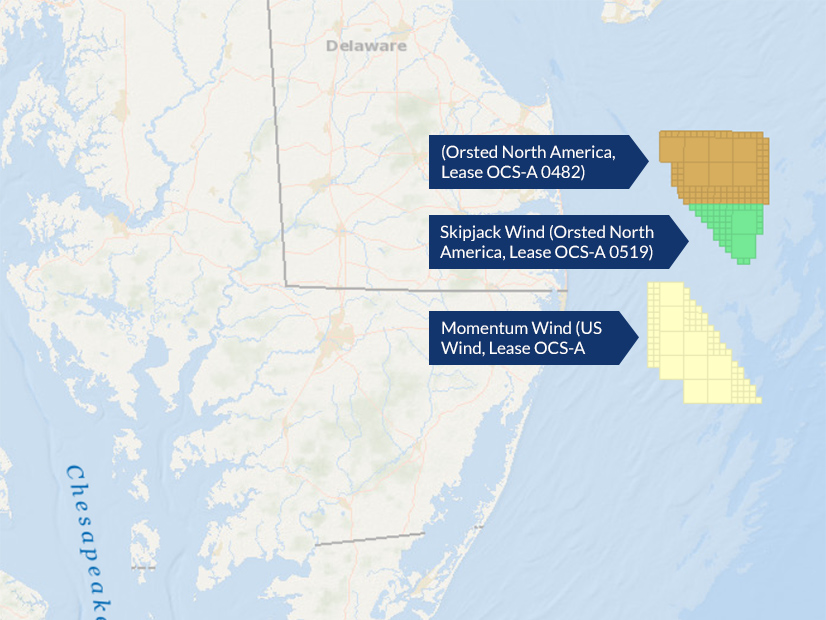Maryland regulators on Friday selected US Wind and Ørsted’s Deepwater Wind to build 1,600 MW in offshore wind, completing the state’s second OSW solicitation and bringing the state close to 2,000 MW in total.
The Public Service Commission awarded US Wind 808.5 MW in offshore wind renewable energy credits (OREC) at a levelized price of $54.17/MWh and Deepwater’s Skipjack Offshore Energy 846 MW at $71.61/MWh. Both awards are for 20 years from when the projects become operational, which is expected by the end of 2026 (Order 90011).
The new projects are in addition to the 368 MW of offshore wind already being developed by the two companies following the PSC’s first solicitation in 2017. The 2017 ORECs were priced at almost $132/MWh. (See Md. PSC OKs 368 MW in Offshore Wind Projects.)
US Wind submitted three bids and Skipjack submitted two in the latest solicitation, which were evaluated on criteria including costs to ratepayers, economic development impacts and progress on lowering the state’s greenhouse gas emissions. The PSC said the new projects would result in almost $1 billion in spending and create more than 10,000 new direct jobs in Maryland.
The commission said it concluded the round 2 projects can be built without exceeding the bill caps set by the state legislature: 88 cents/month for residential customers and no more than 0.9%/year for commercial and industrial customers.
The Clean Energy Jobs Act of 2019 charged the commission with procuring at least 1,200 MW of OSW in its second solicitation. Because this round yielded 1,600 MW, the PSC is cancelling plans for additional procurements as part of round 2.
The PSC’s award requires that the developers create at least 10,324 direct jobs during the development, construction, and operation of the projects and include goals for involving small, local and minority businesses.
The developers also agreed to use port facilities at Tradepoint Atlantic in Sparrows Point outside Baltimore and in Ocean City for marshalling, operations and maintenance. US Wind has previously pledged to develop a monopile construction facility at Sparrows Point while Skipjack has committed to build subsea cable and turbine tower manufacturing facilities in the state and invest in upgrades to Crystal Steel Fabricators, an Eastern Shore company that assembles steel components for wind turbine foundations.
The two companies will also pay $6 million each to the Maryland Offshore Wind Business Development Fund, a grant program for offshore wind supply chain and workforce training initiatives administered by the Maryland Energy Administration.
“The effects of climate change are real, and with its more than 3,000 miles of tidal shoreline, Marylanders are especially vulnerable,” PSC Chair Jason M. Stanek said. “That’s why it is important for the commission to take this action that will put our state on a path of deeper decarbonization and help Maryland achieve its aggressive clean energy goals.”
US Wind won a federal lease in 2014, paying $8.7 million for a site off Maryland that it says has capacity for 1.5 GW. Its Momentum Wind project will be 15 miles from shore at its closest point.
Skipjack’s windfarm will be 20 miles offshore. The Interior Department’s Bureau of Ocean Energy Management (BOEM) leased the site in 2012 to Bluewater Wind Delaware, which sold it to Deepwater Wind in 2016 (#OCS-A 0519). Ørsted acquired Deepwater Wind from D.E. Shaw group in 2018.
Ocean City officials had asked the PSC to require no turbines within 30 miles of shore to ensure they were not visible from land. (See Maryland Offshore Wind Plans Draw Enthusiasm, Controversy.)
The commission declined, saying the projects are sited in federal waters and are subject to BOEM’s review.
The PSC said Ocean City’s request that it require all turbines be located at least 30 miles from shore “is not reasonable in that it would disqualify all existing bids and unreasonably delay the next steps towards a greener energy future for Maryland as envisioned by the legislature. … The applicants are constrained by their lease areas, over which the commission has no control.”
The PSC said, however, that it will require the projects to use “the best commercially reasonable efforts to minimize the viewshed impacts.”




